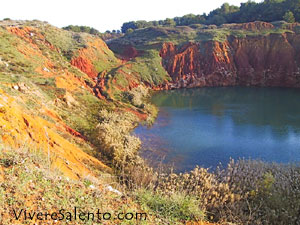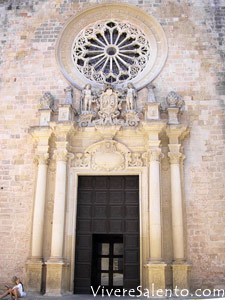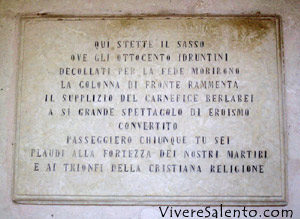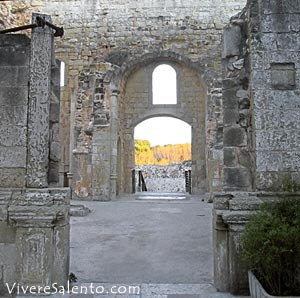|
|

The imposing Castle of Otranto was planned by Roberto il Guiscardo, but it has
been restored several times so
far. In 1088, after an earthquake, it was partially damaged; in 1228 Frederic II
gave the order to rebuild it but after the Turkish attacks in 1480 it was almost
completely destroyed, and in 1537 Charles V made the castle and the coastal
towers rebuild. It was damaged again by the troops of Napoleon and later it
became a school, a jail and finally a residence. Otranto boasts the presence of
numerous monuments, the most important being the Cathedral of the Lady of the
Announced: originally the inside walls were painted, but in 1480 after the
invasion of the Turks it was turned into a mosque and all the holy images were
destroyed except those of the Madonna. The portal in baroque style is dated 1674
and it was made by Ambrogio Martinelli; the inside walls are decorated with
Byzantine and Romanesque elements, the church is Latin cross, and made up of
three aisles and 14 marble
columns. The wooden ceiling is dated 1698 and it was made build by the Bishop of
that time. The baptismal font and the silver antependium of the high altar date
back to the XVII century. At the back of the right aisle there are the relics of
the 800 Martyrs beheaded by the Turks during the massacre of the 1480. The Turks
left the corpses of the martyrs unburied until, after a year, Alfonso of Aragon
made them bury. The stone on which they were beheaded is under the altar, while
on the same stone there is a wooden statue of the Madonna of the XIV century.
What most strikes the
again by the troops of Napoleon and later it
became a school, a jail and finally a residence. Otranto boasts the presence of
numerous monuments, the most important being the Cathedral of the Lady of the
Announced: originally the inside walls were painted, but in 1480 after the
invasion of the Turks it was turned into a mosque and all the holy images were
destroyed except those of the Madonna. The portal in baroque style is dated 1674
and it was made by Ambrogio Martinelli; the inside walls are decorated with
Byzantine and Romanesque elements, the church is Latin cross, and made up of
three aisles and 14 marble
columns. The wooden ceiling is dated 1698 and it was made build by the Bishop of
that time. The baptismal font and the silver antependium of the high altar date
back to the XVII century. At the back of the right aisle there are the relics of
the 800 Martyrs beheaded by the Turks during the massacre of the 1480. The Turks
left the corpses of the martyrs unburied until, after a year, Alfonso of Aragon
made them bury. The stone on which they were beheaded is under the altar, while
on the same stone there is a wooden statue of the Madonna of the XIV century.
What most strikes the tourists' attention is the mosaic on the ground: it is a
masterpiece of inestimable value and it extends for 800 square metres. The
Archbishop Gionata commissioned it in 1163 to the presbyter Pantaleone that
finished it in 1165.
The subject of this marvellous art work is the tree of Life, that is repeated in
all the aisles. In the central one the tree represents the symbol of the
creating Logos, and there are some scenes representing the eternal struggle
between Good and Evil: Adam and Eve sent away from the Heaven, King Arthur, the
zodiac, the Deluge, the Tower of Babel, Diana and the wounded deer, Alexander
the Great, etc. In the left aisle the tree represents the symbol of the judging
Logos with representations of Heaven and of Hell, while in the right aisle the
tree constitutes the symbol of the Logos that forgives and redeems. Inside the
Cathedral, getting down through a staircase, you can see the famous Crypt dating
back to the XI century: there are five aisles and 42 marble columns with
different types of capitals (Islamic, Asian, Corinthian, Byzantine, Syrian,
etc.). The Byzantine Church of St. Pietrodates back to the IX century: there are
three aisles, eight columns and some wonderful paintings as the Maundy, the Last
Supper and the baptism of Jesus. On the hill of the Martyrs, so denominated
since it was the theatre of the terrible martyrdom of 1480, there is the
Sanctuary of St Maria of the Martyrdoms dated 1614 and the ex Convent of the
Minimi built in 1542 after the baroque style. At a distance of a km tourists' attention is the mosaic on the ground: it is a
masterpiece of inestimable value and it extends for 800 square metres. The
Archbishop Gionata commissioned it in 1163 to the presbyter Pantaleone that
finished it in 1165.
The subject of this marvellous art work is the tree of Life, that is repeated in
all the aisles. In the central one the tree represents the symbol of the
creating Logos, and there are some scenes representing the eternal struggle
between Good and Evil: Adam and Eve sent away from the Heaven, King Arthur, the
zodiac, the Deluge, the Tower of Babel, Diana and the wounded deer, Alexander
the Great, etc. In the left aisle the tree represents the symbol of the judging
Logos with representations of Heaven and of Hell, while in the right aisle the
tree constitutes the symbol of the Logos that forgives and redeems. Inside the
Cathedral, getting down through a staircase, you can see the famous Crypt dating
back to the XI century: there are five aisles and 42 marble columns with
different types of capitals (Islamic, Asian, Corinthian, Byzantine, Syrian,
etc.). The Byzantine Church of St. Pietrodates back to the IX century: there are
three aisles, eight columns and some wonderful paintings as the Maundy, the Last
Supper and the baptism of Jesus. On the hill of the Martyrs, so denominated
since it was the theatre of the terrible martyrdom of 1480, there is the
Sanctuary of St Maria of the Martyrdoms dated 1614 and the ex Convent of the
Minimi built in 1542 after the baroque style. At a distance of a km from the Hill of the Martyrs you can see the ruins of the Monastery of St.
Nicola of Casole, that thanks to Niceta of Otranto became the most famous
cultural centre of that period. An other church was dedicated to the Martyrs of
Otranto, that of St. Francesco, built in 1600. In the historical centre you can
see the Church of St Maria dell'Alto Mare and near the harbour there is the
Church of the Madonna del Passo. An other interesting monument to see is the
lighthouse of Palascia Punta, the most eastward place in Italy, built in 1867.
North of Otranto there are the Alimini Lakes surrounded by a thick vegetation:
they constitute a suggestive landscape and an important attraction for the
tourists; near the lakes there are two caves, Sacara Cave in which some
decorations of the Neolithic Age were found and Marisa Cave (Palaeolithic Age).
from the Hill of the Martyrs you can see the ruins of the Monastery of St.
Nicola of Casole, that thanks to Niceta of Otranto became the most famous
cultural centre of that period. An other church was dedicated to the Martyrs of
Otranto, that of St. Francesco, built in 1600. In the historical centre you can
see the Church of St Maria dell'Alto Mare and near the harbour there is the
Church of the Madonna del Passo. An other interesting monument to see is the
lighthouse of Palascia Punta, the most eastward place in Italy, built in 1867.
North of Otranto there are the Alimini Lakes surrounded by a thick vegetation:
they constitute a suggestive landscape and an important attraction for the
tourists; near the lakes there are two caves, Sacara Cave in which some
decorations of the Neolithic Age were found and Marisa Cave (Palaeolithic Age).

The people of
Otranto are well known for being "children of the Turks": this reputation is
closely connected to
 the
tragic event of 1480, the year when the Turks invaded the town committing any
type of abuse towards the population and above all towards the women that were
wildly raped. According to the tradition from July 28th to 12th August 1480
(when the Turks conquered Otranto) the population fought bravely. The day of the
massacre the first man who was beheaded was Antonio Pezzullo: according to the
legend, after his decapitation, his body went on standing until the death of the
last martyr. One of the executioners, Berlabei, was so struck by that event that
he decided to convert to the Christian religion an he was killed quite that day. the
tragic event of 1480, the year when the Turks invaded the town committing any
type of abuse towards the population and above all towards the women that were
wildly raped. According to the tradition from July 28th to 12th August 1480
(when the Turks conquered Otranto) the population fought bravely. The day of the
massacre the first man who was beheaded was Antonio Pezzullo: according to the
legend, after his decapitation, his body went on standing until the death of the
last martyr. One of the executioners, Berlabei, was so struck by that event that
he decided to convert to the Christian religion an he was killed quite that day.
|